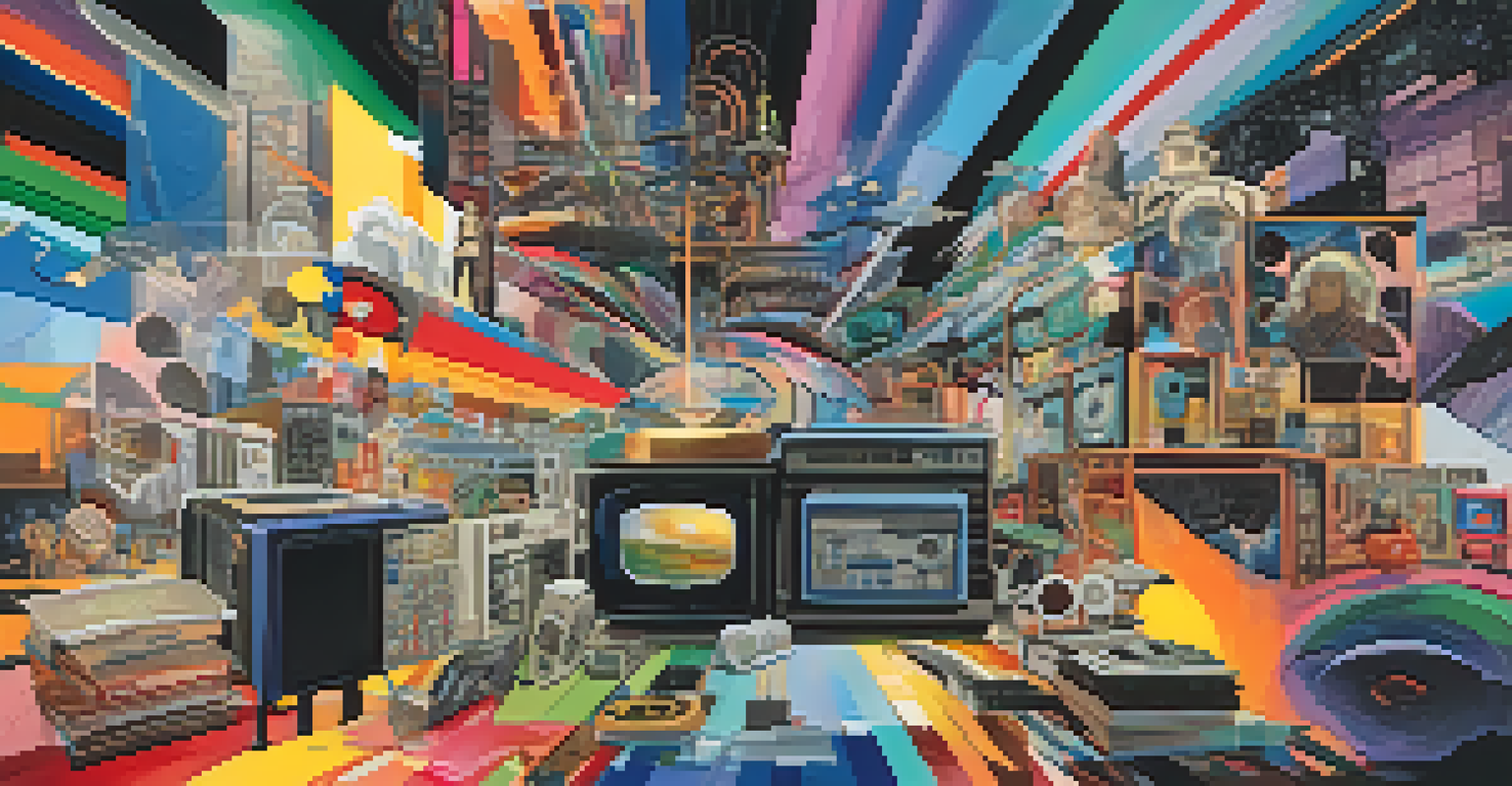The Rise of Streaming: How It Changed Film Genres Forever

The Streaming Boom: A New Era for Film Consumption
In the past decade, streaming services like Netflix and Hulu have reshaped how we consume films. Where once we had to wait for a theater release, we can now watch new films from the comfort of our homes. This shift has not only changed viewing habits but has also influenced how films are produced and marketed. Audiences can binge-watch entire seasons or enjoy films at their own pace, creating a more personalized viewing experience.
Streaming services have provided a platform for diverse voices and stories that might not have found a home in traditional cinema.
With streaming, access to a vast library of films has become possible. This democratization means that niche genres that may have struggled in theaters can find their audience online. For instance, independent and foreign films now have a platform to thrive, reaching viewers who may never have seen them otherwise. As a result, the streaming landscape has fostered a more diverse array of film genres.
Moreover, the rise of streaming has led to increased competition among platforms, encouraging innovation in storytelling. Filmmakers are now exploring unique narratives and experimental formats that may not have been viable in traditional cinema. This evolution has allowed for creative freedom and has ultimately enriched the film landscape.
Genre Blending: The New Norm in Streaming Content
Streaming platforms have given rise to a trend of genre blending, where traditional boundaries between genres are blurred. Shows and films are increasingly combining elements from different genres, creating fresh and exciting narratives. For example, the success of series like 'Stranger Things' combines sci-fi, horror, and coming-of-age elements, appealing to diverse audience preferences.

This genre fusion allows filmmakers to experiment and engage viewers who might have varied tastes. It also encourages storytelling that reflects the complexity of real life, where experiences are rarely confined to a single genre. Audiences are drawn to these unique combinations, often leading to discussions and theories that enhance viewer engagement.
Streaming Transforms Film Access
Streaming services have democratized film access, allowing diverse genres and independent films to reach wider audiences.
Additionally, streaming algorithms analyze viewer preferences, promoting genre-blending content that aligns with what audiences love. This data-driven approach enables platforms to cater to niche audiences while also appealing to the mainstream. As a result, we see a surge in innovative storytelling that defies traditional genre classifications.
The Impact of Binge-Watching on Storytelling
Binge-watching has transformed how stories are crafted in film and television. With viewers able to consume entire seasons in one sitting, creators are now designing narratives that encourage this behavior. Cliffhangers and intricate plotlines keep audiences hooked, making them eager to watch the next episode or film.
The future of storytelling is interactive, and audiences will play a crucial role in shaping the narratives they engage with.
This shift has led to a more serialized approach to storytelling, where character arcs and plots can develop over multiple episodes or films. Creators can delve deeper into character development and subplots, enriching the overall narrative experience. This style has become a hallmark of successful streaming content, leading to more complex and engaging stories.
Moreover, binge-watching fosters community discussions and fan theories, enhancing viewer participation. Online platforms and social media allow fans to share their thoughts, dissect episodes, and connect with others who share their enthusiasm. This communal experience around binge-watching has redefined how audiences interact with film and television.
The Role of Original Content in Shaping Genres
Streaming services have invested heavily in original content, reshaping the landscape of film genres. By producing exclusive films and series, platforms can establish their unique identities and attract subscribers. Original content often pushes the boundaries of traditional genres, leading to innovative storytelling.
For example, Netflix's success with original films like 'Roma' and 'The Irishman' showcases a commitment to diverse narratives that might not have found a place in theaters. These films have garnered critical acclaim and sparked conversations about genre expectations and storytelling techniques. This investment in originality has encouraged other platforms to follow suit, leading to a rich tapestry of film genres.
Binge-Watching Shapes Storytelling
The binge-watching trend has led creators to design more serialized narratives, enhancing character development and viewer engagement.
As streaming services continue to prioritize original content, we can expect to see even more genre experimentation. This evolution allows for the emergence of new sub-genres, as creators draw inspiration from various sources. The result is a vibrant and dynamic film landscape that reflects the shifting preferences of modern audiences.
Audience Engagement: The Power of Interactivity
One of the most exciting aspects of streaming is the potential for interactivity, allowing audiences to engage with content in new ways. Some platforms have experimented with interactive films, where viewers can make choices that influence the story's outcome. This innovative format has transformed passive viewing into an active experience, drawing audiences deeper into the narrative.
For instance, Netflix's 'Black Mirror: Bandersnatch' allowed viewers to make decisions for the main character, leading to multiple endings. This interactivity not only captivates audiences but also sparks discussions about the implications of choice in storytelling. It invites viewers to think critically about the narratives they consume and their role in shaping them.
As interactive content continues to evolve, we can anticipate more filmmakers exploring this format. It opens up possibilities for new genres that blend gaming elements with traditional storytelling. This intersection of film and interactivity may redefine audience engagement, making it a key aspect of future film genres.
Globalization of Film Genres Through Streaming
Streaming platforms have played a pivotal role in the globalization of film genres, breaking down geographical barriers. Viewers can now access international films and series that were once difficult to find, expanding their cinematic horizons. This exposure has led to a richer understanding of diverse cultures and storytelling traditions.
For example, the success of South Korean films like 'Parasite' on platforms like Hulu and Netflix has introduced global audiences to new narrative styles and themes. This trend has encouraged filmmakers worldwide to share their stories, leading to a cross-pollination of ideas and genres. Audiences are more likely to explore international content, challenging the dominance of traditional Hollywood narratives.
Globalization of Film Genres
Streaming platforms have facilitated the globalization of film genres, enabling audiences to explore international narratives and cultural storytelling.
As globalization continues to shape the film landscape, we can expect to see more collaborations between filmmakers from different countries. This fusion of cultural influences can give rise to completely new genres that reflect a blend of traditions and storytelling techniques. The result is a vibrant global film community that enriches the viewing experience for everyone.
Future Trends: What Lies Ahead for Film Genres
As the streaming landscape evolves, so too will the film genres we see in the future. The rise of virtual reality (VR) and augmented reality (AR) may introduce entirely new ways to experience stories, further blurring the lines between genres. These technologies could create immersive experiences that allow audiences to engage with narratives in unprecedented ways.
Moreover, as the demand for diverse representation increases, we can expect to see more films that explore underrepresented voices and stories. This shift will likely lead to the emergence of new genres that reflect the complexities of modern society. Filmmakers are poised to respond to audience demands for inclusivity and authenticity, creating a richer tapestry of narratives.

Finally, as streaming continues to grow, the pressure on traditional film distribution will likely lead to further innovation. Filmmakers may adopt new storytelling techniques and formats that cater to the changing preferences of viewers. The future of film genres promises to be dynamic, exciting, and inclusive, driven by the ever-evolving landscape of streaming.